Yorkshire Terrier
- EYE SHAPE?
- You are invited to judge eight Yorkshire
Terriers stacked in profile; however, before you do, please decide which of
these four Toy heads 1, 2, 3 or 4, has correct eye shape? The Standard only
informs that the eyes are "medium in size and not too prominent; dark
in color and sparkling with a sharp, intelligent expression," and that
"the eyerims are dark."

-
- EYE SHAPE ANSWERS
- Judges looking for answers appreciate
published comments like those made by Richard F. Sedlack in 1985 in The
Yorkshire Terrier that inform, "Round eyes are not correct. These like
tiny pig eyes are not the correct Yorkie expression. Oval or almond eyes are
correct."
-
- Number 1 has tiny, perhaps even pig-like
eyes. Number 2 has almond shaped eyes. Number 3 has oval eyes. Number 4 has
large round eyes. I agree, only almond and oval eyes are correct for the
Yorkie. Both of these eye shapes are found in top winners. In addition the
American (AYTC) Illustrated Discussion of The Yorkshire Terrier, 1979
describes almond shaped eyes as correct and oval shaped eyes as preferred,
which confirms they are not one and the same shape.
-
-
- CIRCLED QUESTIONS
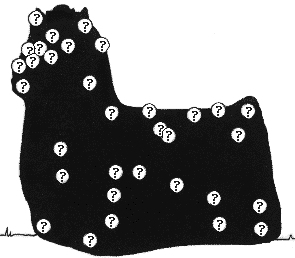 Each
of these circled question marks (?) strategically positioned on this Yorkie
silhouette represents a question not answered in the breed Standard. This
large a number of unanswered questions is not unusual in Toy breeds having
distinctively long and colorful hair cover.
Each
of these circled question marks (?) strategically positioned on this Yorkie
silhouette represents a question not answered in the breed Standard. This
large a number of unanswered questions is not unusual in Toy breeds having
distinctively long and colorful hair cover.
- Breeder judges will tell you this is not
so. One Yorkie breeder judge writes, "The Yorkshire Terrier Standard is
really quite good, if only judges would judge by it." True, however you
must remember that breeder judges live with the breed. They do not need a
breed Standard to tell them what height is correct for seven pounds, what
length the legs or the body should be, what shape the eyes should have, what
the correct length for the muzzle should be, or if the body has a degree of
tuck-up; they know, studying all these things; but they did not find these
things out from studying the Yorkie Standard.
-
-
-
- TWO CLASSES TO JUDGE
- Place the first four bitches in the
American Bred class in order of Yorkshire Terrier merit, then do the same
for the four in the Open Bitch class.
-
- AMERICAN BRED CLASS A,B,C,D
- All four bitches in this first class have
correct heads, the differences and the focus is on correct height to body
length proportions, tail carriage, and visible color features. All are sound
and none weigh more than seven pounds (3.2 kg), i.e., "Weight must not
exceed seven pounds."
-
 PROPORTIONS
PROPORTIONS
- The first two bitches in line are slightly
longer than tall, the second's topline appearing optically shorter because
of high (12 o'clock) carriage of tail. The last two in line are square, but
not square in the same way. Bitch C is square because her body is shorter
than the other three. Bitch D is square because she has longer legs than
Bitches A, B and C.
-
- TAILS
- As for carriage of tail, the Standard
advises "carried slightly higher than the level of the back."
Bitch B's higher than "slightly" continues to gain in appeal. The
correct slightly above the topline tail is often wrongly downgraded to:
"the dog that does not show" in the United States.
-
- The only other obvious judging feature that
differs between these first four is Bitch B's lighter coat color. She is
silver blue. In this instance the Standard advises that the correct color is
"Dark steel blue not a silver blue." Color is fully described in
Yorkie Standards and articles, in fact you could walk across North America
on the reams of paper that elaborate on the appearance, condition, care and
grooming of Yorkshire Terrier coat and color but only get across the room on
paper describing in detail what should be found hidden beneath the coat.
-
- TIME FOR YOUR DECISIONS
- These then are the features involved in
this American Bred Class judging scenario: height to length proportions, leg
length, tail carriage, and coat color. Place these four in order of merit
before going on to the next class, in the spaces provided below.
-
-
-
-
-
- MY PLACEMENTS
- I placed these four bitches in the same
order that they came into the show ring. I gave slightly longer than tall
Bitch A first place; Bitch B. with the silver blue color second; short
bodied square Bitch C third; and long legged, square Bitch D fourth.
-
-
-
-
- PUSHED FOWARD TAIL
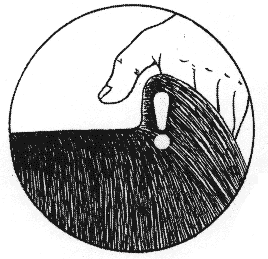 The
exhibitor's forefinger pushing this Yorkie's tail forward is a common
practice. The intent of this subterfuge is to optically shorten the very
topline and to make the dog appear more alert. Some very high set Yorkie
tails do not require assistance to position perpendicular, and some carry
(lift) their tails upright (allowed by AYTC) at the trot. When the Standard
is revised, Yorkshire Terrier fanciers will probably delete the word "slightly"
from "carried slightly higher than the level of the back".
Fanciers will probably also more closely associate the advice that "hair
on the tail is a darker blue, especially at the end of the tail" and
include this advice in the paragraph describing the tail.
The
exhibitor's forefinger pushing this Yorkie's tail forward is a common
practice. The intent of this subterfuge is to optically shorten the very
topline and to make the dog appear more alert. Some very high set Yorkie
tails do not require assistance to position perpendicular, and some carry
(lift) their tails upright (allowed by AYTC) at the trot. When the Standard
is revised, Yorkshire Terrier fanciers will probably delete the word "slightly"
from "carried slightly higher than the level of the back".
Fanciers will probably also more closely associate the advice that "hair
on the tail is a darker blue, especially at the end of the tail" and
include this advice in the paragraph describing the tail.
-
-
-
- OPEN BITCH CLASS
E,F,G,H
- Heads, height, weight, toplines and again
tails are factors taken into consideration when judging this class.
-
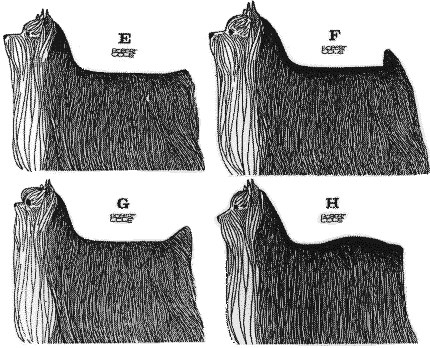 MUZZLE
MUZZLE
- The Standard limits description of the head
to: "small and rather flat on top, the skull not too prominent or
round, the muzzle not too long." I see the muzzle as less than half the
length of skull, about in a ratio of 2 to 3. The bridge of the fairly broad
tapering muzzle is level and parallel with the top of the skull. The stop is
definite. The nose is black and the nostrils are open.
-
- None of these four muzzles are correct.
Bitch E's muzzle is long; Bitch F's muzzle (in fact the whole head is large
and heavy); Bitch G's muzzle is short and (doll face) and her eyes large and
round; and Bitch H's muzzle is not on the same plane as skull, producing a
down-face effect.
-
- OVERWEIGHT
- Bitch F is taller and weighs much more than
seven pounds (3.2 kg). With experience you can tell with your eyes and your
hands if a Yorkie is overweight. Overweight usually means gross but not
always. Sometimes greater soundness goes hand in hand with greater size. It
is then that awareness that this is a Toy breed and the Standard's demand,
"must not exceed seven pounds," takes on special meaning.
-
- In the USA, a judge has the authority to
make a determination as to whether a Yorkie does not exceed seven pounds,
provided such a determination has not been made previously during
competition at the show. Judges in Canada do not have this authority. In
Canada a scale (or a measure) can only be used if there is a weight (or
height) disqualification.
-
- TOPLINE
- High withers for most breeds are a
desirable characteristic but not for the Yorkie according to the Standard,
which reads, "the back line level, with height at the shoulder the same
as at the rump."
-
- Only Bitch H has a poor topline. Instead of
level, the topline roaches over the loin and the croup slopes down. You have
probably consigned her to fourth place. If she was a short-coated breed like
the Min Pin, you would be able to determine by sight if her loin roached
because the body was not well ribbed-up combined with a long loin, or
because the pelvis was steep. (A hands-on examination determined this roach
is due to a combination of the two).
-
- TAILS
- All four tails are different. Bitch E's
body is made to appear longer because the tail is not carried high enough.
Bitch F's tail is carried higher than "slightly". Bitch G's tail
has been docked longer (a man-made fault) than "medium" length and
is light instead of dark on the end. Bitch H's tail slopes down.
-
- TIME FOR YOUR DECISIONS
- Place these four in order of merit in the
spaces provided below.
-
-
-
-
- MY PLACEMENTS
- I placed long-muzzle Bitch E first. Based
on what the Standard says and does not say, I gave baby-face Bitch G second
place. Third place went to large and heavy Bitch F, and fourth place to
unsound Bitch H.
-
-
-
- RESERVE WINNER: B
OR E?
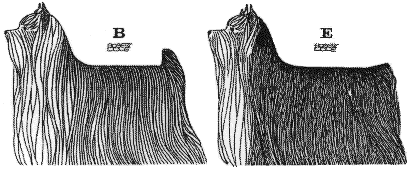
- My Winners Bitch ribbon went to Bitch A.
That was easy! The Reserve Winners Bitch award between silver-blue Bitch B
and long-muzzle Bitch E was a more difficult choice. Both faults are warned
of in the Standard. Which did you select for Reserve? I selected Bitch B
because if bred to steel blue, she was more likely to produce dark blue
color than Bitch E was likely to produce typey heads, and because I
considered the long muzzle to be a more serious fault as well as not being a
head I would want to take home.
-
-
-
- UNOFFICIAL ILLUSTRATED IDEAL
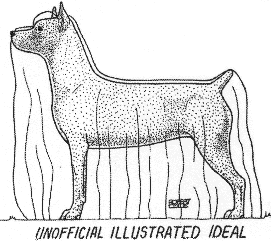 By
employing eight competitors, I was able to open discussion on a number of
conformation questions the 1966 AKC Standard does and does not address;
however there are more, and I have drawn a see-through example to bring them
to your attention.
By
employing eight competitors, I was able to open discussion on a number of
conformation questions the 1966 AKC Standard does and does not address;
however there are more, and I have drawn a see-through example to bring them
to your attention.
- I would remind you that my uncloaked
illustrated ideal is unofficial as are my comment, and comments are confined
to unanswered questions.
- The ratio of muzzle to skull is 2 parts to
3 parts. Muzzle and skull are on parallel planes separated by a definite
stop. The almond-shaped eyes look straight forward (not slanted on sides of
head). The ears join the head closer to occiput than stop. Ears held erect
by tying the hair into the topknot must be penalized. Ears are trimmed short
at the tips.
- I have drawn the neck medium in length and
included a slight arch. There is a point of forechest in front of the point
of shoulder. Angled shoulder blade and angled upper arm appear the same
length. Elbow is level with deepest part of brisket. Elbow positions half
the height from ground to withers (body depth and foreleg length are equal).
Front pastern slopes slightly forward. Body from point of forechest to
buttocks is slightly longer than height at withers. Tuck-up is moderate.
-
- There is a shelf below tail and hind toes
position directly under the buttocks. There is moderate angulation at both
stifle and hock. Rear pasterns position vertical. Feet are tight and
cat-like in addition to "round." (I am not in accord with AYTC
promotion of the lower forelegs toeing out slightly).
-

 Each
of these circled question marks (?) strategically positioned on this Yorkie
silhouette represents a question not answered in the breed Standard. This
large a number of unanswered questions is not unusual in Toy breeds having
distinctively long and colorful hair cover.
Each
of these circled question marks (?) strategically positioned on this Yorkie
silhouette represents a question not answered in the breed Standard. This
large a number of unanswered questions is not unusual in Toy breeds having
distinctively long and colorful hair cover.
 PROPORTIONS
PROPORTIONS
 The
exhibitor's forefinger pushing this Yorkie's tail forward is a common
practice. The intent of this subterfuge is to optically shorten the very
topline and to make the dog appear more alert. Some very high set Yorkie
tails do not require assistance to position perpendicular, and some carry
(lift) their tails upright (allowed by AYTC) at the trot. When the Standard
is revised, Yorkshire Terrier fanciers will probably delete the word "slightly"
from "carried slightly higher than the level of the back".
Fanciers will probably also more closely associate the advice that "hair
on the tail is a darker blue, especially at the end of the tail" and
include this advice in the paragraph describing the tail.
The
exhibitor's forefinger pushing this Yorkie's tail forward is a common
practice. The intent of this subterfuge is to optically shorten the very
topline and to make the dog appear more alert. Some very high set Yorkie
tails do not require assistance to position perpendicular, and some carry
(lift) their tails upright (allowed by AYTC) at the trot. When the Standard
is revised, Yorkshire Terrier fanciers will probably delete the word "slightly"
from "carried slightly higher than the level of the back".
Fanciers will probably also more closely associate the advice that "hair
on the tail is a darker blue, especially at the end of the tail" and
include this advice in the paragraph describing the tail. MUZZLE
MUZZLE

 By
employing eight competitors, I was able to open discussion on a number of
conformation questions the 1966 AKC Standard does and does not address;
however there are more, and I have drawn a see-through example to bring them
to your attention.
By
employing eight competitors, I was able to open discussion on a number of
conformation questions the 1966 AKC Standard does and does not address;
however there are more, and I have drawn a see-through example to bring them
to your attention.